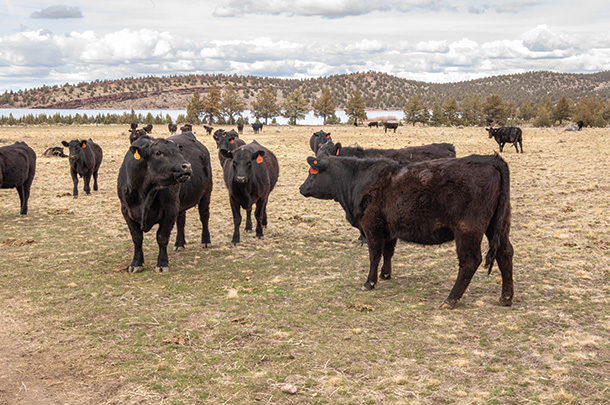One of the most consequential decisions commercial operations make is sire selection. Whether purchasing a bull or choosing an A.I. sire, the decision has a multigenerational impact on an operation.
In the immediate term, selecting the wrong bull can cause calving train wrecks or reduce a calf crop’s performance. Over the long term, the consequences of choosing the wrong bull can be even more significant for herds that keep replacement females.
In the pursuit of improving a herd’s genetics, the big question is often, “What traits should we focus on improving?” While each herd will vary in the characteristics they are focused on improving, I think commercial producers often get tunnel vision and focus exclusively on “revenue traits” and disregard the other traits essential to an operation’s profitability. In my part of the world, where most commercial calves are sold at weaning, much selective pressure has focused on improving calving ease and pre-weaning growth. While these are undoubtedly important to an operation’s profitability, they don’t tell the whole story, especially when replacement females are kept.
Cow longevity and commercial profitability
Cow efficiency and longevity is the make-or-break point of any commercial operation. Developing heifers is not free. A cow does not become profitable until it has its fifth calf. Only then does it recoup the costs associated with development and maintenance. This means breeding replacements that stay in the herd for the long haul is of the utmost importance. The most common reasons cows are culled from commercial herds before they become profitable are:
-
Infertility – An open cow is the least profitable cow on the planet.
-
Poor structural soundness – A cow that can’t travel can’t graze or drink effectively, a direct blow to weaned calf pounds.
-
Poor udder quality – Decreased calf performance, possible infections and added work during calving. Don’t forget your time is worth money.
-
Aggressive disposition – A tame cow might not result in more dollars at the end of the year, but a mean one can erase years of work in a minute.
-
Calving difficulties – Live, unassisted calves are the first step toward a cow’s profitable year.
- Poorly adapted to the environment – Cows that put energy toward cooling/warming/fighting disease aren’t putting it toward raising a calf.
More than convenience traits
Traditionally, these were considered “convenience traits” due to the perception that they impact a producer’s daily workload. However, we know these traits have an inherent economic value, particularly related to cow longevity. We have taken to calling them foundation traits, a term that reflects their outsized importance in the commercial beef herd. Further, we know each of these traits is influenced by genetics, meaning we can select bulls that are more likely to sire more functional and profitable daughters. The genetic improvement of cow-centric traits should be a core goal for any commercial operation retaining replacement females.
Genetic improvement of cow foundation traits
Many of these traits are lowly heritable, meaning that genetics account for only a small portion of the variation in phenotype. Further, many of these traits are not expressed until later in a bull’s daughter’s life. This combination of low heritability and lag in phenotypic expression makes selecting bulls for cow traits more difficult than for calving ease or growth traits. Fortunately, breed associations have used wide-scale phenotype collection efforts to generate genetic predictions for many of these foundation traits. These enable us to focus our selection on the genetic component of these traits.
The most direct measurement of cow longevity is stayability, often abbreviated as STAY. Stayability measures how likely a bull’s daughters are to remain in the herd long enough to recoup their development and maintenance costs. Stayability “successes” are cows that calve as heifers and each of the subsequent four years. Bulls with higher stayability expected progeny differences (EPDs) are likely to have more daughters reach a profitable age and beyond. For example, in the American Simmental breed, daughters of bulls with top 25th percentile stayability EPDs produce an average of two more calves in their lifetime than those from bulls in the bottom 25th percentile.
As I mentioned earlier, there are many reasons why a cow might be culled from the herd before she is profitable. Many other individual traits that impact cow longevity also have EPDs. Genetic predictions exist for other foundation traits like heifer pregnancy rates, foot and leg phenotypes, docility, maternal calving ease, maintenance requirements and environmental adaptability.
Selection indexes for improving cow efficiency
When evaluating a bull’s ability to improve a cow herd, it’s essential to consider multiple traits at once. For example, it doesn’t matter how high a bull’s EPD for heifer pregnancy is if he passes feet and leg issues to his daughters. Simultaneous selection for multiple traits is made more accessible by using economic selection indexes. These indexes account for correlated traits and attach relative economic values to the EPDs, resulting in genetic predictions for profitability. Many breeds report indexes designed for operations that keep replacement females. These indexes (e.g., $M in Angus, API in Simmental, HerdBuilder in Red Angus) place heavy emphasis on these foundation traits without sacrificing calving ease or weaning performance.
Long-lived, low-maintenance and problem-free cows are the cornerstones to a profitable commercial cow herd. It is essential to remember that genetics is only one piece of the puzzle for raising a herd of profitable cows. Environment plays a large part in the expression of these phenotypes and, as a consequence, animals need appropriate levels of management to achieve their genetic potentials. No amount of genetic selection can make up for a lack of proper heifer development or mature cow maintenance. That said, with appropriate levels of management, opportunities exist to use genetic tools to further reduce the costs of developing and maintaining females. Keeping foundation traits in mind when selecting bulls can leave a lasting positive impact on any cow herd.









